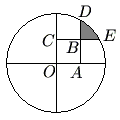Difference between revisions of "2006 AMC 10B Problems/Problem 19"
Ragnarok23 (talk | contribs) |
(Added problem and solution) |
||
| Line 1: | Line 1: | ||
== Problem == | == Problem == | ||
| + | A circle of radius <math>2</math> is centered at <math>O</math>. Square <math>OABC</math> has side length <math>1</math>. Sides <math>AB</math> and <math>CB</math> are extended past <math>B</math> to meet the circle at <math>D</math> and <math>E</math>, respectively. What is the area of the shaded region in the figure, which is bounded by <math>BD</math>, <math>BE</math>, and the minor arc connecting <math>D</math> and <math>E</math>? | ||
| + | |||
| + | [[Image:2006amc10b19.gif]] | ||
| + | |||
| + | <math> \mathrm{(A) \ } \frac{\pi}{3}+1-\sqrt{3}\qquad \mathrm{(B) \ } \frac{\pi}{2}(2-\sqrt{3}) | ||
| + | \qquad \mathrm{(C) \ } \pi(2-\sqrt{3})\qquad \mathrm{(D) \ } \frac{\pi}{6}+\frac{\sqrt{3}+1}{2}\qquad \mathrm{(E) \ } \frac{\pi}{3}-1+\sqrt{3} </math> | ||
| + | |||
== Solution == | == Solution == | ||
| + | The shaded area is equivilant to the area of sector <math>DOE</math> minus the area of triangle <math>DOE</math> plus the area of triangle <math>DBE</math>. | ||
| + | |||
| + | Using the Pythagorean Theorem: | ||
| + | |||
| + | <math>(DA)^2=(CE)^2=2^2-1^2=3</math> | ||
| + | |||
| + | <math>DA=CE=\sqrt{3}</math> | ||
| + | |||
| + | Clearly <math>DOA</math> and <math>EOC</math> are <math>30-60-90</math> triangles with <math>\angle EOC = \angle DOA = 60^\circ </math> | ||
| + | |||
| + | Since <math>OABC</math> is a square, <math> \angle COA = 90^\circ </math> | ||
| + | |||
| + | <math>\angle DOE</math> can be found by doing some subtraction of angles. | ||
| + | |||
| + | <math> \angle COA - \angle DOA = \angle EOA </math> | ||
| + | |||
| + | <math> 90^\circ - 60^\circ = \angle EOA = 30^\circ </math> | ||
| + | |||
| + | <math> \angle DOA - \angle EOA = \angle DOE </math> | ||
| + | |||
| + | <math> 60^\circ - 30^\circ = \angle DOE = 30^\circ </math> | ||
| + | |||
| + | So the area of sector <math>DOE</math> is <math> \frac{30}{360} \cdot \pi \cdot 2^2 = \frac{\pi}{3} </math> | ||
| + | |||
| + | The area of triangle <math>DOE</math> is <math> \frac{1}{2}\cdot 2 \cdot 2 \cdot \sin 30^\circ = 1 </math> | ||
| + | |||
| + | Since <math>AB=CB=1</math> , <math>DB=ED=(\sqrt{3}-1)</math> | ||
| + | |||
| + | So the area of triangle <math>DBE</math> is <math>\frac{1}{2} \cdot (\sqrt{3}-1)^2 = 2-\sqrt{3}</math> | ||
| + | |||
| + | Therefore, the shaded area is <math> (\frac{\pi}{3}) - (1) + (2-\sqrt{3}) = \frac{\pi}{3}+1-\sqrt{3} \Rightarrow A </math> | ||
| + | |||
== See Also == | == See Also == | ||
*[[2006 AMC 10B Problems]] | *[[2006 AMC 10B Problems]] | ||
Revision as of 23:12, 13 July 2006
Problem
A circle of radius ![]() is centered at
is centered at ![]() . Square
. Square ![]() has side length
has side length ![]() . Sides
. Sides ![]() and
and ![]() are extended past
are extended past ![]() to meet the circle at
to meet the circle at ![]() and
and ![]() , respectively. What is the area of the shaded region in the figure, which is bounded by
, respectively. What is the area of the shaded region in the figure, which is bounded by ![]() ,
, ![]() , and the minor arc connecting
, and the minor arc connecting ![]() and
and ![]() ?
?
![]()
Solution
The shaded area is equivilant to the area of sector ![]() minus the area of triangle
minus the area of triangle ![]() plus the area of triangle
plus the area of triangle ![]() .
.
Using the Pythagorean Theorem:
![]()
![]()
Clearly ![]() and
and ![]() are
are ![]() triangles with
triangles with ![]()
Since ![]() is a square,
is a square, ![]()
![]() can be found by doing some subtraction of angles.
can be found by doing some subtraction of angles.
![]()
![]()
![]()
![]()
So the area of sector ![]() is
is ![]()
The area of triangle ![]() is
is ![]()
Since ![]() ,
, ![]()
So the area of triangle ![]() is
is ![]()
Therefore, the shaded area is ![]()










